Research Questions:
Can climate sensitive facade interventions reduce the intensity of the Urban Heat Island effect within urban blocks in arid climates?“
Research Goal:
The goal is to propose simplified, climate-sensitive facade interventions in highly urbanized cities that reduce energy loads by mitigating Urban Heat Island (UHI) effects, while complying with climate-resilient regulations. These interventions will aim to enhance urban livability and sustainability by improving outdoor thermal comfort.
#01 THE PROBLEM
The impact of UHI in urban microclimates and the urgency for intervention.
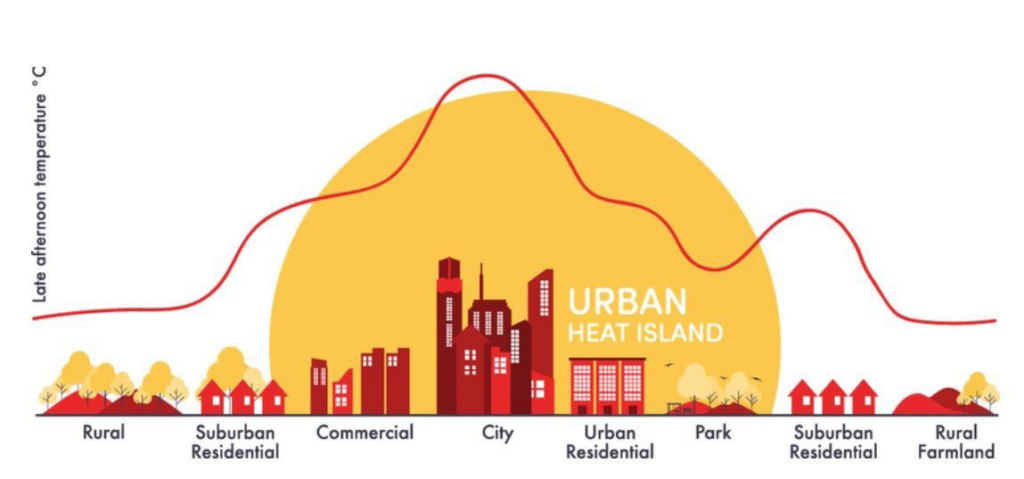
01 | 1 UHI and the Impact
The Urban Heat Island (UHI) effect is a phenomenon where urban areas experience higher temperatures than their rural counterparts due to human activities and modified land surfaces (Santamouris, 2020). This is shaped by long-term planning decisions, which significantly impact the microclimatic conditions of highly urbanised cities. It is also especially significant in arid climates, where high solar radiation and minimal vegetation intensify the UHI effect. This effect leads to numerous undesirable conditions within the living environment.

01 | 2 Major Drivers
Rapid urbanization and the widespread use of materials like concrete and asphalt where the surface temperatures are 10-20°C higher than surrounding areas with vegetation contribute significantly to UHI. Limited vegetation in urban environments further exacerbates this issue, as natural cooling processes like evapotranspiration are scarce. Additionally, the dense clustering of buildings can see UHI effects increase, increasing the surface temperatures of urban elements by up to 5-7°C. (Irfeey et al., 2023) High population densities generate more heat through increased energy use and vehicular emissions as well, intensifying the UHI effect in highly urbanized microclimates.
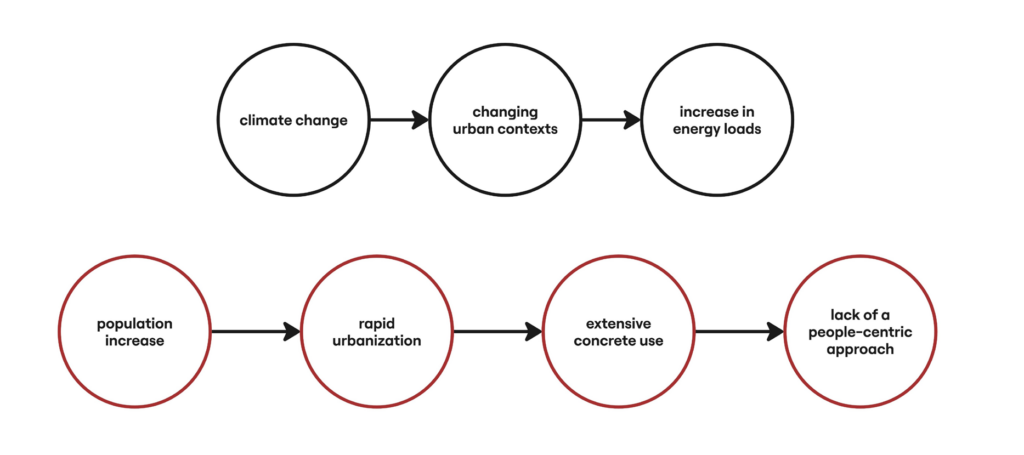
01 | 3 Consequences on People and Cities

Higher urban ambient temperatures have a serious impact on citizen‘s life and the overall environmental quality of cities. Elevated temperatures increase the demand for air conditioning in arid climates, leading to higher energy consumption and costs. (Santamouris, 2020). The UHI effect poses health risks, particularly for vulnerable populations, as it can exacerbate heat-related illnesses and reduce overall thermal comfort. As much as the AEC industry is exploring solutions to mitigate UHI, the urgency in creating more liveable urban microclimates need to be severely addressed by integrating energy-efficient building materials, implementing green solutions, and using advanced environmental tools to optimize buildings and urban blocks.
# 02 STATE OF THE ART
Existing climate-sensitive facade techonologies and tools.
02 | 1 Climate-Sensitive Façades
In order to understand what kind of interventions are possible, the current existing methods and designs were evaluated. Spanning from early history with limited usage of materials and technology into more advanced intervention methods and systems.
From these examples we derive our key parameters for our intervention systems, such as the integration of shading elements, use of vegetation for natural insulation and cooling, selection of high-reflectivity or thermal mass materials, and the development of modular, adaptable systems.
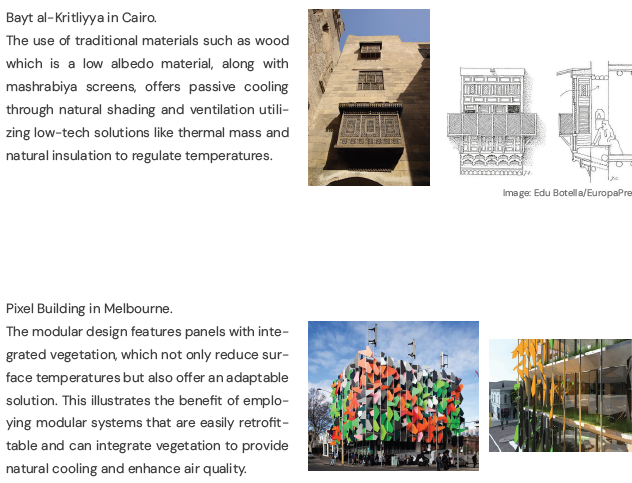
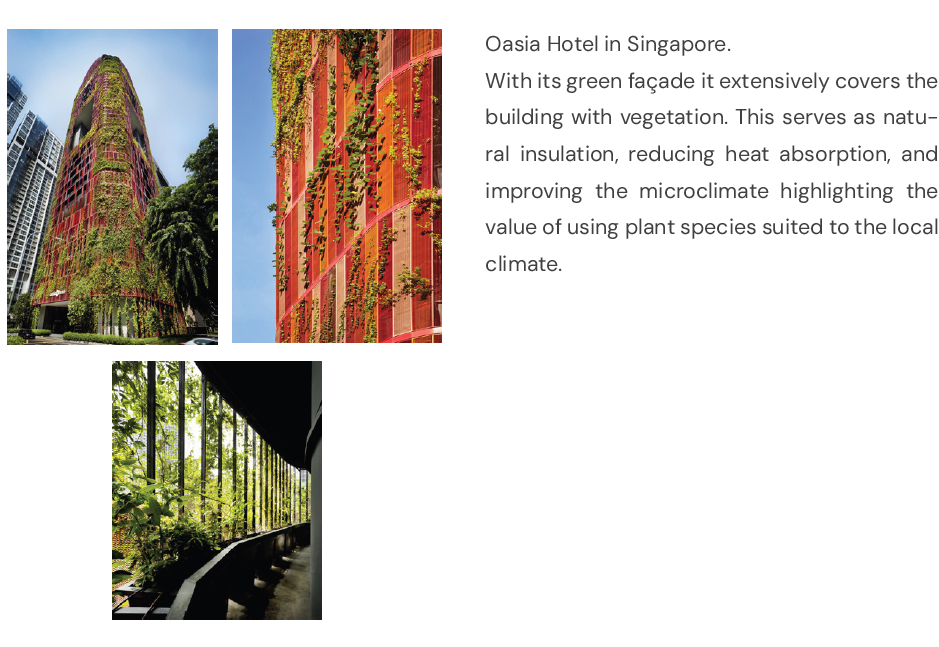

RETROFIT
For specific techniques on green building facades, there are no established concepts. (Amorim & Mendonça, 2016) But through literature review we can establish the modular and retrofitting methods in more detail. The implementation of vertical green systems illustrated in the diagrams by Ling. T. offers a scalable and adaptable strategy with various levels of façade greening using the Leaf Area Index (LAI) method, highlighting how increasing green coverage whether partial or full on building façades and roofs can enhance the thermal performance of urban blocks.


MODULAR PANELS
Modular panels are a green façade system characterized by prefabricated structures that allow for the installation of plants in a pre-arranged manner. The modules vary in size, enabling complex shapes for diverse design needs which will be tested in our research. The modules are installed with the plants already set in place, and their planting is simple, as the substrate is compressed within the panel cells. An automatic drip irrigation system distributes water through the panels, which drains excess at the bottom.

MOVE GREEN
The MoVe Green system designed by Intewa is a mobile vertical façade greening solution that enhances traditional façade greening by allowing for easier maintenance and irrigation using treated greywater. Its modular design can be retrofitted onto existing buildings without major structural alterations. This approach is still being tested in Germany, and currently has a limited application on low to mid rise buildings.

#03 INTERVENTION APPROACH

Various tools are used to measure UHI and other factors in extreme climates such as QGIS and ArcGIS and are employed for spatial analysis of UHI effects enabling the identification of urban heat hot spots. In terms of design and simulation, we will be specifically using Ladybug Tools in Grasshopper with EnergyPlus, Radiance and URBAN opt which allow for detailed modelling of building and urban performance.
In arid climates, the primary performance criteria for façades focus on solar avoidance, as these regions do not experience extreme temperature swings or seasonal changes. This leads to us focusing on sun hours, radiation, and sun exposure to further evaluate our UHI values.
03 | 1 UHI & LST
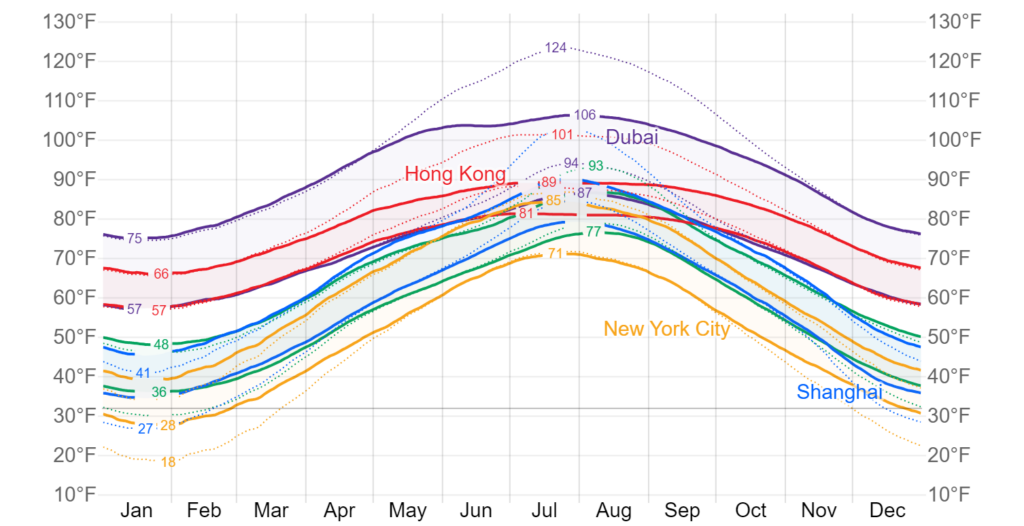
Five cities were analysed through QGIS to compare their UHI and LST values. The cities were chosen based on the 5 factors defined in chapter 1.2 Major Drivers. Rapid urbanization, extensive use of concrete, limited vegetation and high population densities. From this analysis it was determined that 4 cities including Shanghai, Dubai, Tokyo and Hongkong reached high levels in the UHI scale during midday in the summer months with Dubai and Hongkong reaching critical levels of 40°C – 50°C spanning into the spring and autumn months. As the worst case scenario we chose Dubai as our evaluative case study location.





The UHI and LST effect in Dubai demonstrates a variation across the city by the UHI values ranging from -2.166 to 1.794. These values represent the intensity of heat accumulation in different urban areas. The highest UHI values, concentrated in densely built-up areas, reflect a heat retention effect due to the extensive use of heat-absorbing materials such as asphalt, concrete, and metal, which lack the cooling benefits provided by green spaces or water bodies.
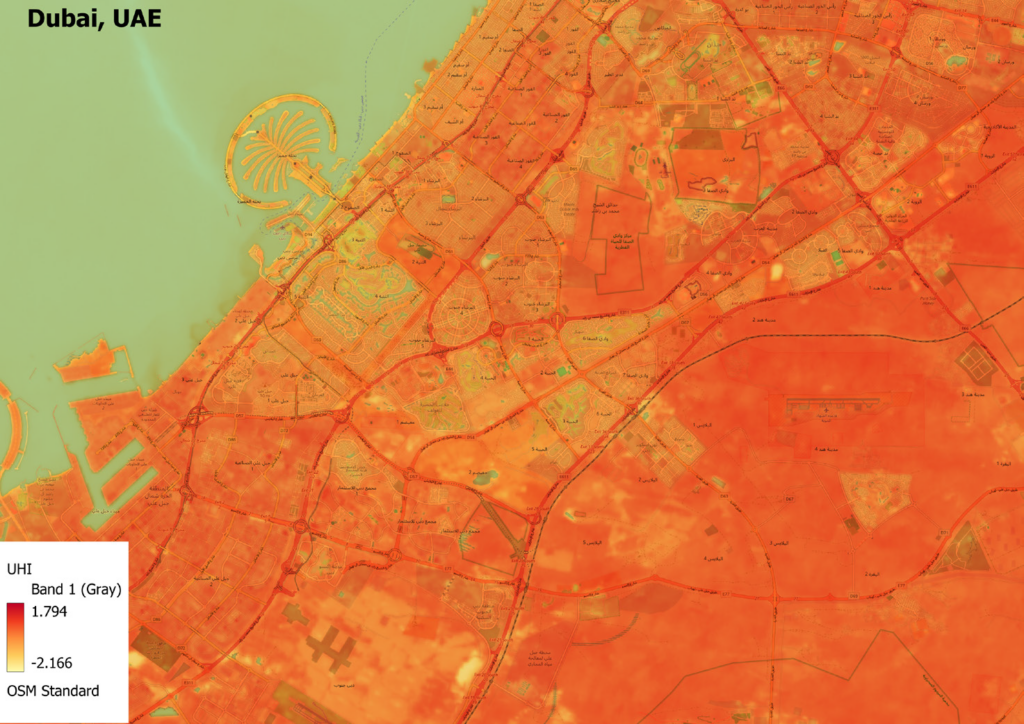
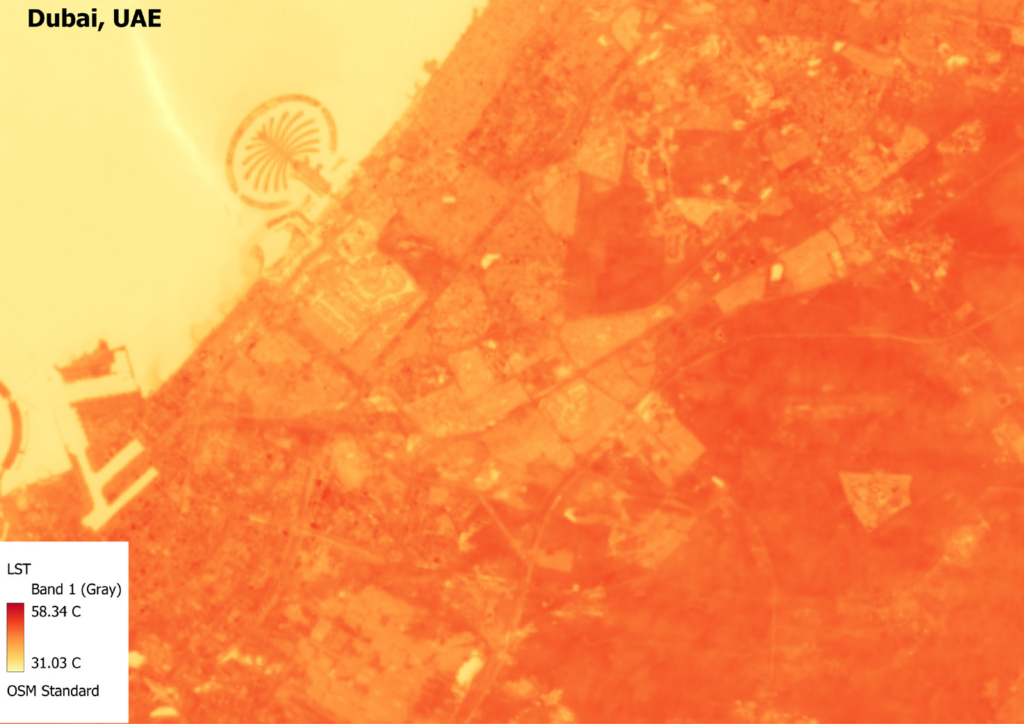
03 | 2 Case Study
Old Town Deira has become a neglected district overshadowed by the city’s modern developments. Known for its dense urban layout, narrow streets, and aging infrastructure, Deira suffers significantly from the Urban Heat Island effect. The area’s outdated building designs, largely made from concrete and glass, absorb and trap heat, intensifying temperatures and putting strain on residents who rely heavily on air conditioning. As an area often overlooked in urban planning, addressing the UHI effect here can offer a valuable case study for how low cost, adaptable façade systems can be applied to older urban districts, setting the way for similar
retrofitting efforts in hot-climate cities worldwide.
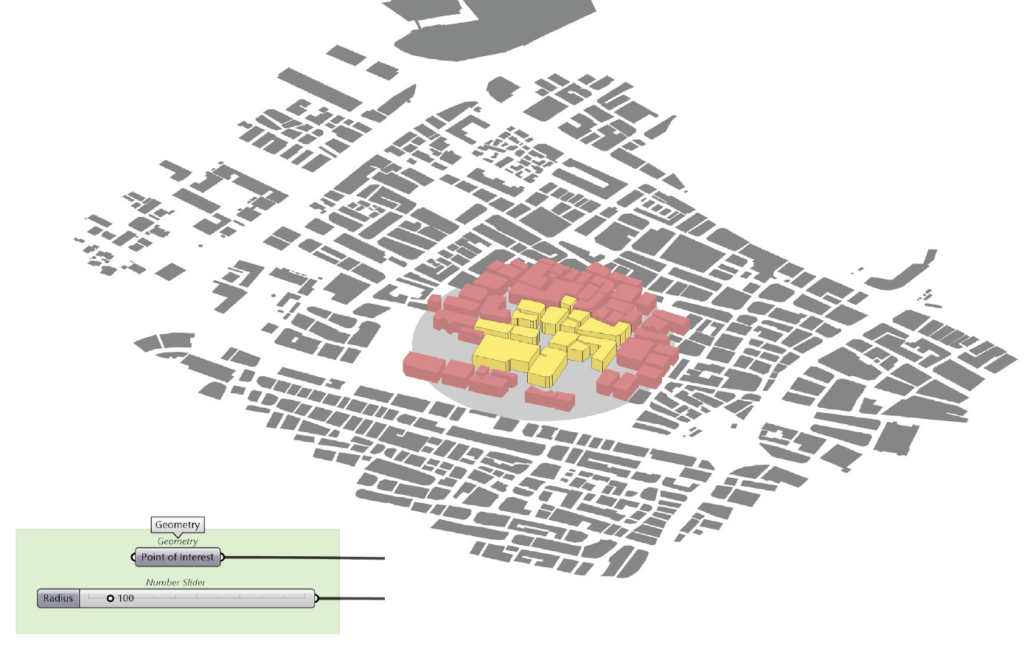
The location is imported through Urbano and through a parametric selection tool the point of interest and the radius in the area can be set according to preference. The inner area within the radius is set as the intervention site and the outer area as context. With the use of Dragonfly the Urban Deira EPW is generated and compared with the original EPW of Dubai which indicated that the high temperatures are constant in both, but the Urban Deira EPW values have a less drop in temperature during the evening where the original EPW drops by 3°C more.
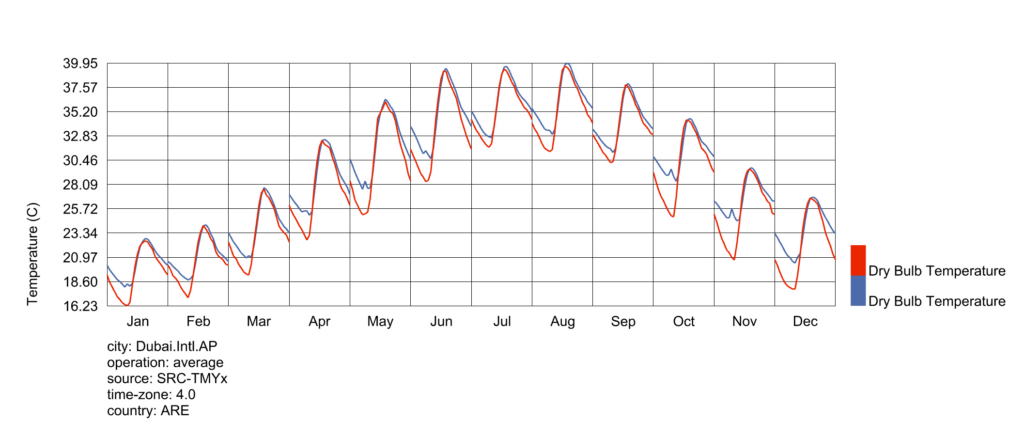
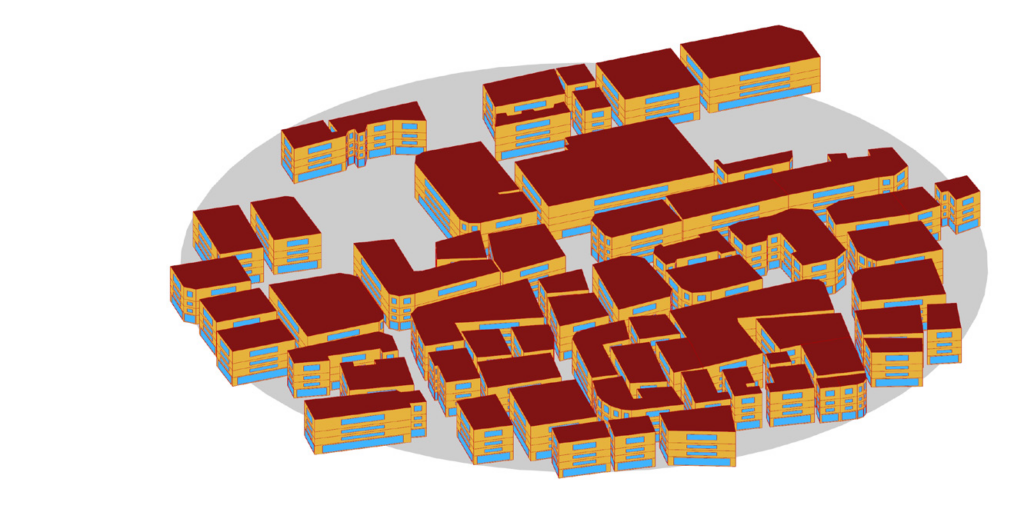
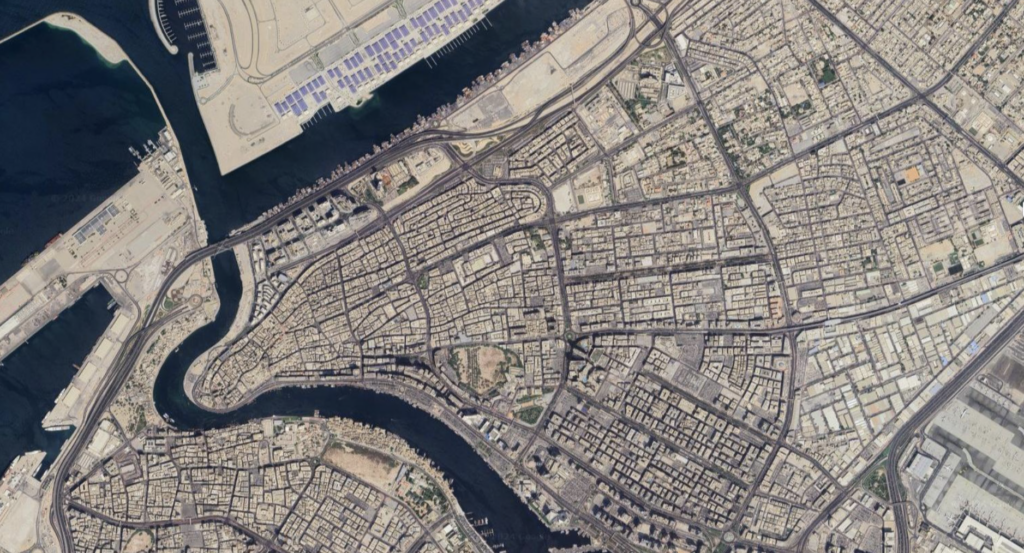
CLIMATE ANALYSIS
Initial Sun Hours were analysed on the intervention blocks as seen from the North East and South West directions with the Urban EPW. In order to extract the intervention points on the facades a tolerance of 3.00 was set to get the areas in which the retrofit modular facades can be implemented. As the location is an arid climate the tolerance was thought to be appropriate to reduce the amount of sun hours and reduce energy usage indoors.

Initial Incident Radiation was analysed on the intervention blocks as seen from the North East and South West directions with the Urban EPW. In order to extract the intervention points on the facades a tolerance of 2.00 was set to get the areas in which the retrofit modular facades can be implemented. The mesh grids which have values higher than the tolerance are selected. As the location is an arid climate the tolerance was thought to be appropriate to reduce the amount of harmful radiation and enchance occupancy comfort.

03 | 3 Proposed Interventions
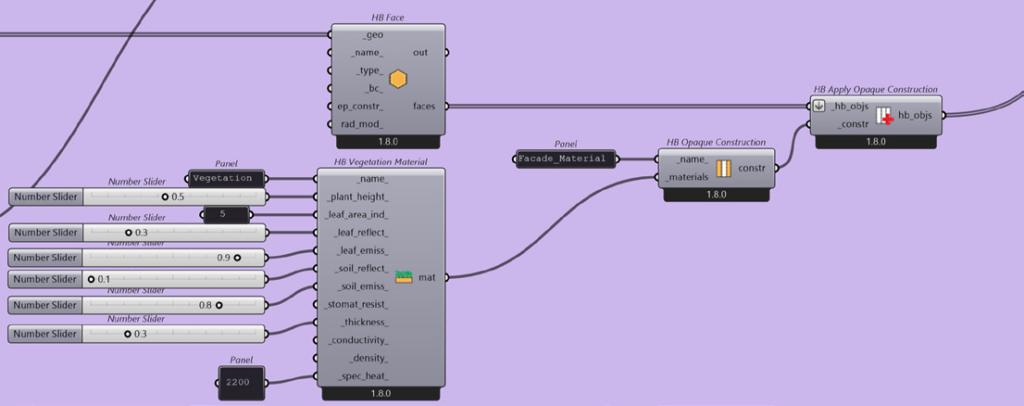
Facade intervention methods were designed to analyse on the facades in micro scale. The first floor of the buildings were eliminated from intervening as they contain retails. The variation in the sun hours can be seen with each implementation of its corresponding module. Each module was set as a green vegetation material through Honeybee in order to get an accurate representation of the module as the greenery would be covering the modules eventually. Facades 3 and 4 will be taken into consideration for optmization as the dimensions remain the same the surface areas are lower hence can be considered to be more adaptable.

The intervention facades were further evaluated in terms of reducing the radiation and sunlight exposure. Facade intervention 4 was taken as the final candidate for optimization and implementation in the macro urban scale.
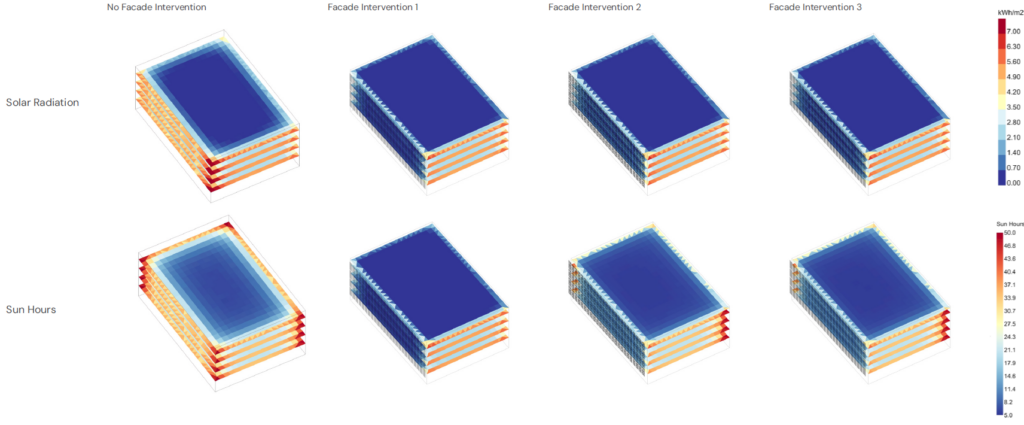
03 | 4 Implementation & Optimization
A three-step optimization process through evolutionary solver, Galapagos (one-objective) was conducted to shape the most fitting and responsive model within the typology. The most suitable angle and orientation for the facades in order to reduce solar radiation and sun hours were optimised.
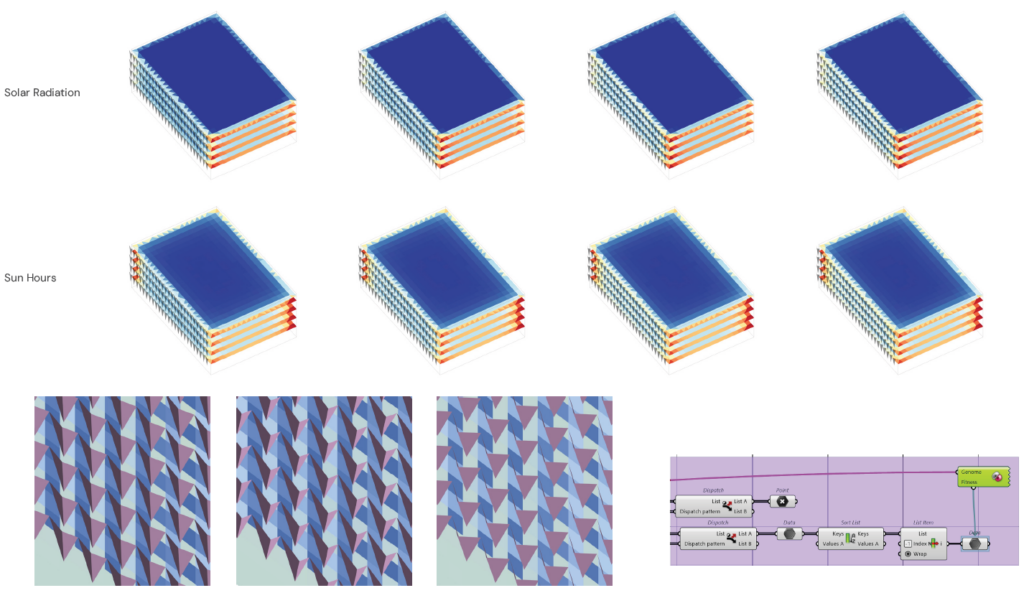
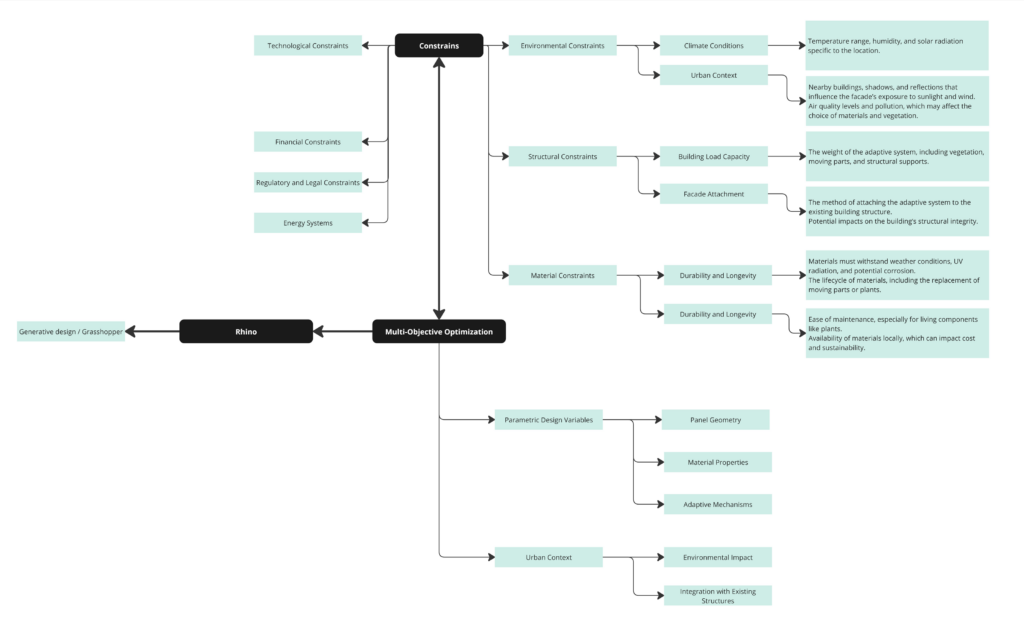
03 | 5 Intervened Performance Evaluation
With the application of facade 3 and 4 on the intervention blocks and multi objective optimization for facade 4 the analysis was re-evaluated on the urban scale in terms of UHI mitigation. The results indicated that there wasa reduction with a 2°C drop during the evening.
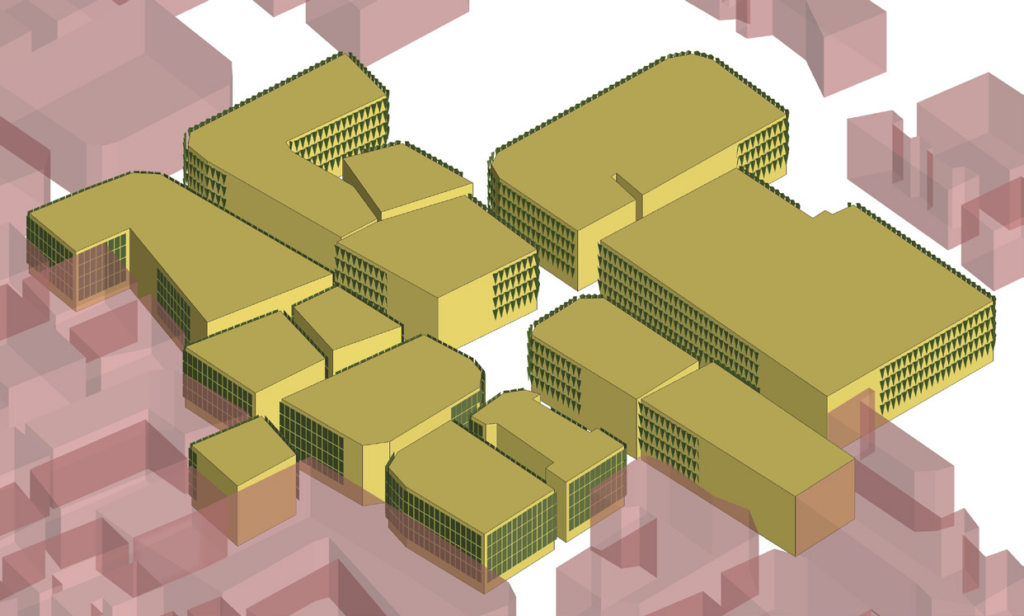

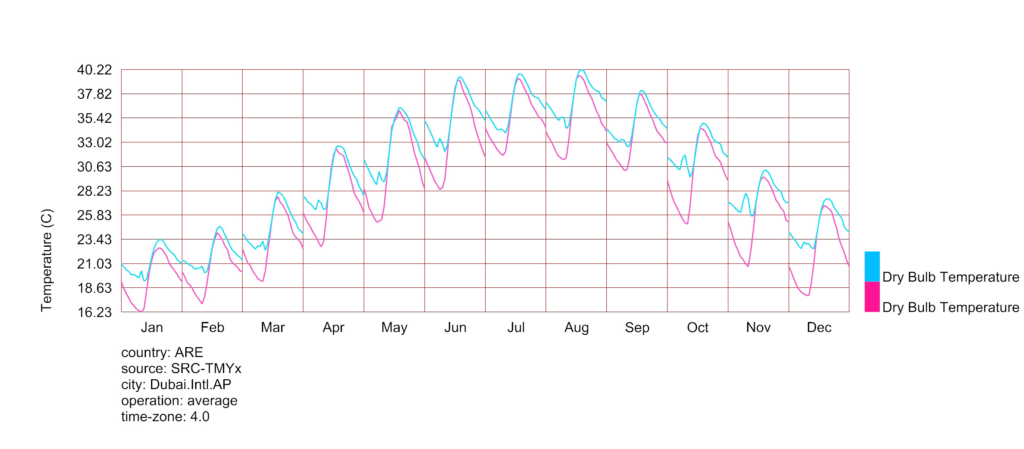
#04 Outlook & Next Steps
04 | 1 Integration into Various Building Typologies
The diversity of building forms and functions within urban environments means that even within a single typology there will be significant variation. Further research would be needed to create adaptable systems that can be fine-tuned to address local microclimatic conditions and building typologies. Also each building presents unique characteristics such as height, orientation, materiality, and function that influence how façade interventions will perform.
One approach could be the development of a modular, adaptive façade system that can be tailored to meet the specific needs of different building types. Such a system would consist of standardized components that can be arranged and combined in various configurations. This modularity would allow the system to be adjusted depending on the urban form. It would also make it more cost-efficient by reducing the need for entirely custom façade retrofits for each project.
Another approach would be to create variations of façade systems based on building typologies. Instead of developing a one size fits all system, designing multiple façade intervention types each optimized for specific categories of buildings.
04 | 2 Future ML Directions
As this research was focused on a specific location and urban typology, the results are limited to application in similar scenarios with limited intervention types.
The use of AI and machine learning algorithms to optimize facade performance by predicting how different façade configurations will respond to varying climatic conditions would be beneficial. By creating a large dataset including climate data, building performance metrics, and material properties of the interventions, supervised ML models can be trained in order instantaneously decipher results for similar situations. This can be later on extended to various other climatic conditions and façade variations for different building typologies in order to create an open-source database which can be re-trained with each addition of façade typology, adaptive system and climate.
The end goal would be creating open-source datasets and predictive models that can be shared and adapted across different urban contexts whilst constantly evolving.
Possible ML models can be Random Forest regressor for predicting UHI effects based on a combination of inputs like building geometry, material properties, and environmental data. XGBoost to capture complex patterns in the data, which is useful when analysing the interaction of different urban and environmental factors. Linear and Polynomial Regression could also be used in the early stages of the predictions to analyse relationships between factors including nonlinear relationships.

#05 Conclusion
This thesis investigated the role of climate-sensitive façade interventions in mitigating the Urban Heat Island (UHI) effect, specifically targeting Old Town Deira in Dubai—a densely populated and neglected area with outdated infrastructure. By selecting an urban block in this district, such interventions can be adapted to other underdeveloped urban environments facing similar challenges. Four façade designs were initially explored, but two were selected based on their equal efficacy in UHI mitigation, combined with lower material costs and lighter weight, making them more viable for large-scale implementation. This decision underscores the importance of cost-effective and adaptable solutions for UHI mitigation, particularly in aging urban areas. The methodology which included parametric selection and optimization, offers a framework for improving urban resilience and thermal comfort in cities globally.
While the chosen designs proved effective, their integration into buildings require careful consideration of structural constraints, and installation complexities can arise due to limited accessibility in the dense urban environment. These would have to be take into consideration in the development of this research.
The research demonstrated that parametric selection and optimization of façade interventions can deliver environmental benefits. The methodology applied here provides a framework for replicating such interventions in other arid and vulnerable regions. While further research is required to refine these approaches, particularly in relation to long-term maintenance and performance, the outcomes of this thesis can offer a foundation for future efforts to enhance urban resilience in densely populated areas.

